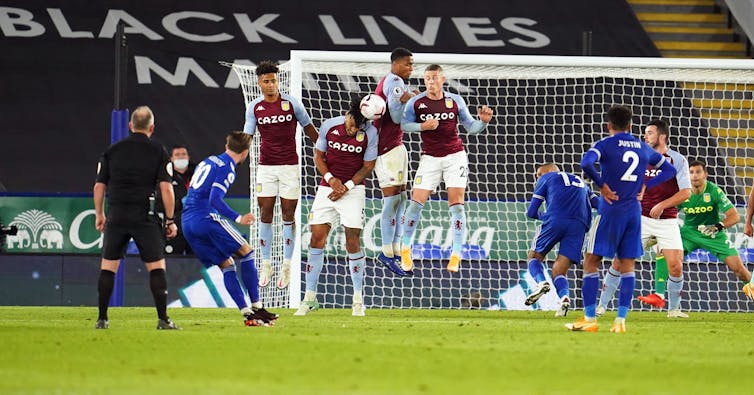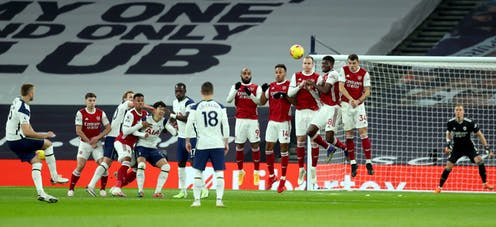In football, free kicks occur when the referee believes a rule has been broken. If central enough and within 30 metres from the goal, the attacking team typically attempts a direct shot on goal. However, the goalkeeper routinely places a “wall” of defensive players in between the ball and the goal to complicate the kicker’s task of shooting on target.
While this strategy is often effective, the wall frequently obstructs the goalkeeper’s initial view of the moving ball. Although the negative effects of this obstruction have been assumed by experts, they had not been scientifically quantified until recently.
To do so, our team created a goalkeeping simulator using virtual reality. Both eyes see the world from slightly different perspectives, which gives us our 3D vision. Virtual reality creates the sense of seeing a 3D world by presenting distinct images to both eyes using a head-mounted display.
The exact images of the virtual scene presented to both eyes depend on the continuously measured position and direction of the person’s head, which are imported into a software model of the virtual world and the objects within it, which we can also see on a separate screen. This model includes virtual hands, the positions of which are updated continuously based on the measured position of additional sensors attached to the actual hands.
A virtual football is moved along a trajectory that accounts for gravity and the aerodynamic effects of air friction and spin. When making contact with other objects (hands, goal, ground), the ball rebounds. This simulator can also be used to show the goalkeeper a realistically moving avatar of the kicker based on recordings of actual free kicks (as our team did previously for cricket).
Key effects of the wall
In our study it was clear that obstructing the initial view of the ball affects the goalkeeper. When the ball comes into view later, moving initially behind the wall, goalkeepers start moving later, leaving less time for them to get in between ball and goal.
Without a wall the goalkeeper can get their hands closer to the ball, resulting in more saves than with a wall. We found that the wall was more beneficial for faster free kicks, and for free kicks that require movement of the goalkeeper’s whole body.
The effects were very consistent and are likely to be more substantial in the real world where free kicks warrant larger movements of the goalkeeper and where a wall also partially hides the kicker (although a kicker was not shown in this version of our simulator). However, we would certainly not suggest goalkeepers never use a wall again.
Our results suggest that any decision not to place a wall during a free kick is most relevant for fast kicks from central positions that leave the goalkeeper little time. The negative effects will be more apparent when facing expert free kick takers, who consistently shoot free kicks around or over the wall and on target.
Exploiting the defensive wall
Capitalising on our findings requires a data-driven approach. Goalkeepers and trainers would need to weigh the odds that the kicker shoots into the wall against the improved performance from the goalkeeper being able to see the entire ball flight. The first may be estimated from historic figures for each free kick taker; the latter requires tests on the field or tests using a virtual reality simulator.
A factor we didn’t address is how the wall may act as a reference for the kicker’s aim. Expert kickers have been reported to aim their shots over a specific player’s head. Without a wall this reference point would not be there, which could negatively affect their kick. On the other hand, the absence of a wall allows for harder and lower shots, which some argue would make free kicks even harder to stop.

Jon Super/EPA
Our research confirms that a goalkeeper’s ability to stop a free kick is hindered by visual obstruction caused by the defensive wall of players – a disadvantage that teams have been exploiting in free kick scenarios over the years. Attacking teams, for instance, commonly place additional players in the wall. Under the current rules, these players must stand at least a metre from any player in the defending wall to avoid physical interference. However, even at a metre distance these additional players can still interfere with play by obstructing the goalkeeper’s view. The common use of this strategy shows teams understand the potential benefits of obstructing the goalkeeper’s view.
Free kicks are and will remain a game of cat and mouse between goalkeeper and kicker. Our findings suggest goalkeepers should improve their view of the ball while attacking teams should seek to maximise the goalkeeper’s visual obstruction of the ball. Combined with historic information about opponents’ decisions and movements, our findings help guide the search for more effective free kick strategies.
![]()
Joost C. Dessing received funding from the European Union Seventh Framework Programme FP7-CIG under grant agreement n° 334202.
Cathy Craig is a co-founder of INCISIV Ltd. She receives funding from Innovate UK.
Theofilos Valkanidis receives funding from the European Union's Horizon 2020 research and innovation programme under the Marie Sklowdowska-Curie grant agreement n° 754507.











